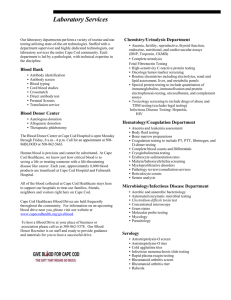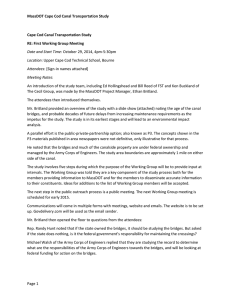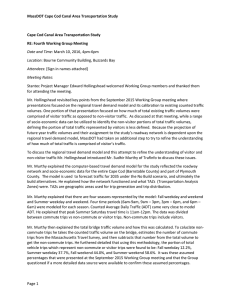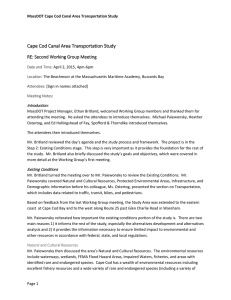Cape Cod Canal Transportation Study, Second Public Meeting. Bourne, Plymouth, Sandwich, Wareham.
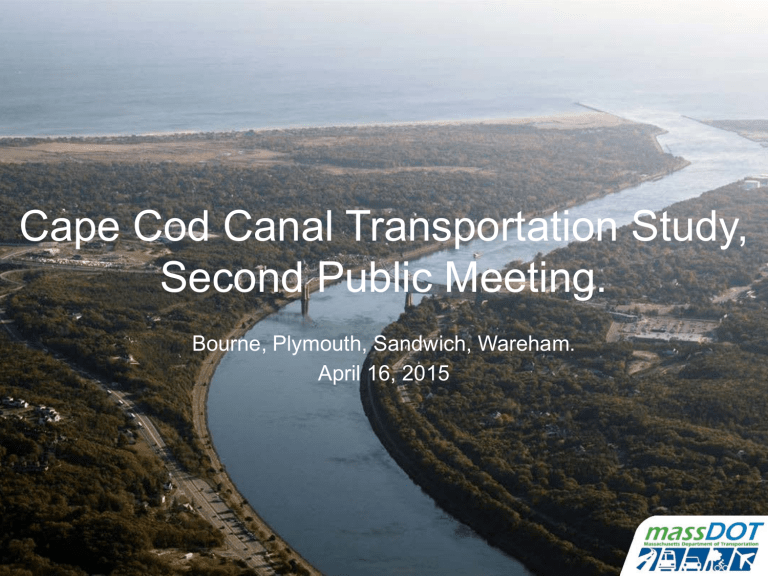
Cape Cod Canal Transportation Study,
Second Public Meeting.
Bourne, Plymouth, Sandwich, Wareham.
April 16, 2015
1 | April 16, 2015
Agenda.
•
•
•
•
•
Welcome and Introductions.
Study Process & Framework.
Study Framework: Goals and Objectives.
Existing Conditions.
• Natural and Cultural Resources,
•
•
Protected Environmental Areas,
Infrastructure,
•
•
Demographic Information,
Transportation (Traffic, Transit, Bikes,
Pedestrians).
Schedule/Next Steps.
2 | April 16, 2015
Welcome and Introductions.
•
•
•
MassDOT:
• Ethan Britland – Project Manager,
• Diane Madden – MassDOT Environmental,
US Army Corps of Engineers.
• Michael Walsh, P.E.
Study Team:
• Bill Reed, P.E., Principal in Charge (FST)
•
•
•
• Ed Hollingshead, AICP - Team Project Manager (FST),
Michael Paiewonsky, AICP – Environmental Planner (FST),
Heather Ostertog, P.E. – Transportation Engineer (FST),
Ken Buckland, AICP – Public Involvement (Cecil Group).
3 | April 16, 2015
Study Process & Framework.
• Step 1: Goals and Objectives, Evaluation
Criteria, and Public Involvement Plan.
• Step 2: Existing Conditions.
• Step 3: Future Conditions, Alternatives
Development, and Issues Evaluation.
• Step 4: Alternatives Analysis.
• Step 5: Recommendations.
4 | April 16, 2015
Study Framework: Goals.
• To create/improve multimodal mobility in the
Cape Cod Canal area.
• To establish an alternative or replacement crossing of the Cape Cod Canal to address the diminishing quality and reliability of year-round connectivity over the Cape Cod Canal, due to the aging Sagamore and Bourne Bridges.
5 | April 16, 2015
Study Framework: Objectives.
• Create reliable multimodal connectivity and mobility levels such that the quality of life on Cape Cod is not diminished by unreliable connectivity across the Cape
Cod Canal.
• Create a reliable multimodal connection across the Cape
Cod Canal to maintain/enhance public safety in the event of the need for an emergency evacuation of portions of Cape Cod and to accommodate first responders accessing Cape Cod.
• Ensure that cross canal connectivity does not become a barrier to reliable intra-community connectivity for the
Towns of Bourne and Sandwich.
6 | April 16, 2015
Existing Conditions:
Study’s Foundation.
7 | April 16, 2015
Existing Conditions Sets the Stage.
• Would an improvement cause an impact to:
• natural resources?
• cultural resources?
8 | April 16, 2015
9 | April 16, 2015
10 | April 16, 2015
Existing Conditions Sets the Stage.
• What are the travel problems?
• Where are the summer and non-summer travel demands?
• Where are the congested locations?
• Where are crash locations?
• What is the extent of the multimodal options?
11 | April 16, 2015
Are all congested locations equally important?
• Out of 37 locations analyzed only 18 have congested operations
.
• Out of those 18 locations only 9 have operational problems year-round.
12 | April 16, 2015
Existing Conditions.
•
•
•
•
•
Natural and Cultural Resources.
Protected Environmental Areas.
Infrastructure.
Demographic Information.
Transportation (traffic, transit, bikes, and pedestrians).
13 | April 16, 2015
Study Area.
14 | April 16, 2015
Natural and Cultural Resources
MassGIS is the source for the information for the natural and cultural resources and infrastructure.
15 | April 16, 2015
Wetlands & Waterways.
16 | April 16, 2015
FEMA Flood Hazard Areas.
17 | April 16, 2015
Fisheries.
18 | April 16, 2015
Rare & Endangered Species.
19 | April 16, 2015
Historic Resources.
20 | April 16, 2015
Historic Resources.
21 | April 16, 2015
Residential Areas.
22 | April 16, 2015
Protected Environmental Areas
23 | April 16, 2015
Open Space.
24 | April 16, 2015
Areas of Critical Environmental Concern.
25 | April 16, 2015
Drinking Water Protection Areas.
26 | April 16, 2015
Hazardous Materials.
27 | April 16, 2015
Environmental Justice Communities.
28 | April 16, 2015
Infrastructure
29 | April 16, 2015
Railroad Lines.
30 | April 16, 2015
Utilities.
31 | April 16, 2015

